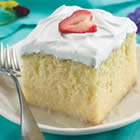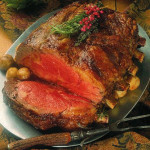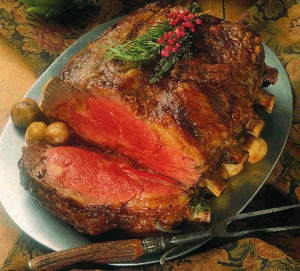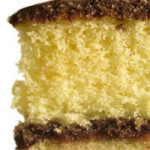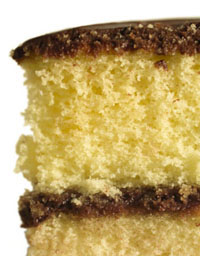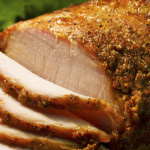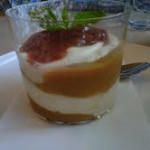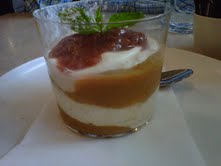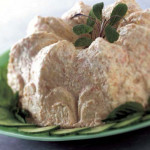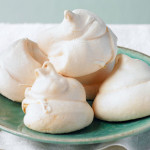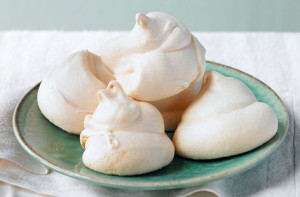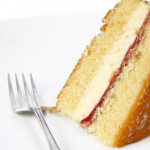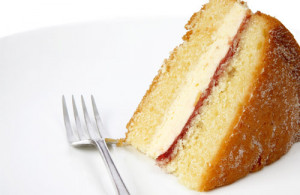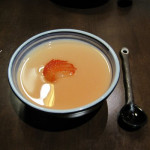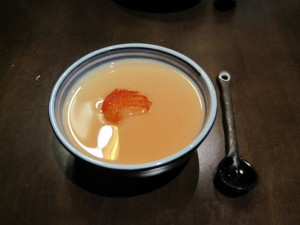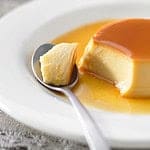Pastel Tres Leches
INGREDIENTS
1 ½ Cups Unbleached Flour
1 Teaspoon Baking Powder
½ Teaspoon Salt
6 Eggs
1 Cup Sugar
4 Teaspoons Vanilla Extract
14 Ounces Sweetened Condensed Milk
12 Ounces Evaporated Milk
3 Cups Heavy Cream
2 Tablespoons Sugar
Optional Fresh Fruit
Preheat the oven to 350° F. Grease a 9×3 inch spring form pan. In a medium bowl sift the flour, baking powder and salt together. In a separate medium bowl mix (with a mixer) the eggs and sugar together. Beat on high for 5 minutes. Reduce the speed and add the water and one teaspoon of the vanilla. Mix well. Gently fold the flour mixture into the egg mixture. Pour the batter into the spring form pan and bake for 35 to 45 minutes by placing the cake in the center of the oven. The cake should be firm in the center and starts to pull away from the sides of the pan. Remove from the oven and cool on a wire rack for 15 minutes. Place a plate over the cake and turn upside down to remove the cake from the pan. Next gently place the cake right side up onto your serving dish.
To serve make sure your platter has a lip to hold in the milk. In a bowl, mix together the evaporated milk, the condensed milk, 1 cup of the heavy cream and 2 teaspoons of vanilla. Using a long tooth pick, ice pick or skewer, poke holes all over the cake. The holes will allow the cake to absorb more of the milk. Slowly pour or spoon the milk mixture all over the cake and allow it time to soak in before adding more milk. Refrigerate. When ready to serve the cake, place the 2 cups of whipping cream in a chilled mixing bowl and begin mixing on medium. Add one teaspoon of vanilla and sugar one tablespoon at a time. Beat on high until stiff peaks form. Spread the whipping cream generously on the top of the cake. Garnish with sliced fruit if you like. Serves 8
Prime Rib Roast “Au Jus”
Prime Rib Roast or Standing Rib Roast is a cut of beef from the rib section. The entire rib section comprises ribs six through twelve of the cow, but can comprise anywhere from two to seven ribs. A slice of Prime Rib Roast will include portions of the “eye” of the rib as well as the outer, fat marbled muscle known as the “lip” or “cap.” The traditional preparation for this roast is to rub the outside with salt and seasonings and slow-roast with dry heat. In the U.S., it is common for bbq purists to apply smoke to the uncooked rib roast at low heat for 2 to 3 hours before dry roasting. In England, Yorkshire Pudding is frequently served as a side dish with prime rib.
INGREDIENTS
3 ½ Teaspoons Sea Salt
1 ½ Teaspoon Freshly Ground Black Pepper
3 Cloves Roasted Garlic
4 Tablespoons Softened Butter
1 Tablespoon Finely Chopped Fresh Thyme Leaves
1 Tablespoon Finely Chopped Fresh Rosemary
1 Prime Rib Roast of Beef (4 to 6 Bones)
2 ½ Cups Red Wine
2 ½ Cups Beef Stock
Preheat the oven to 450° F. Place the garlic cloves in a small bowl and mash with the back of a fork until mostly smooth. Add softened butter, 1 teaspoon salt, ½ teaspoon pepper, the rosemary and thyme, and stir to blend. Pat the mixture evenly over the top and sides of the roast. Season the roast all over with the remaining 2 ½ teaspoons of salt and 1 teaspoon of pepper. Place the roast in a roasting pan and add 1 ½ cups red wine and ½ cup beef stock to the bottom of the pan. Roast for 20 minutes. Reduce the heat to 350° F and continue to roast to the desired degree of doneness. Roast 18 minutes per pound for rare and 22 minutes per pound for medium. Let stand at least 5 minutes before carving.
To make the au jus, place the roasting pan on the stove burners over medium-high heat. Add 1 cup of the red wine and scrape the browned bits on the bottom of the pan with a wooden spoon. Add 2 cups beef stock and season with salt and pepper. Continue to cook for 5 minutes until the wine is reduced by half. Strain the sauce through a sieve to remove the solids before serving. Degrease if necessary. Servings 4 to 8 depending on how hungry you are!
Basic Yellow Cake
I love this recipe. It is incredibly versatile. If you want to add fruit or flavorings to the cake you can. Use whatever frosting that you wish. Dress this cake up or dress it down. You can use this recipe for layer cakes, cupcakes, loaf cakes or specialty pan cakes. It suits all occasions from everyday to a special occasion.
INGREDIENTS
3 Cups Sifted Cake Flour
2 ½ Teaspoons Baking Powder
½ Teaspoons Salt
1 ¾ Cups Sugar
2/3 Cup Softened Butter
2 Eggs
1 ½ Teaspoons Vanilla Extract
1 ¼ Cups Milk
Preheat the oven to 350° F and grease tow 8 inch round cake pans. Line prepared cake pans with parchment paper. In a medium bowl sift together the flour, baking powder and salt. Set aside. In a large bowl cream together the butter and sugar until light. Next, add the eggs and vanilla to the creamed butter and sugar mixture until thoroughly combined. Add the flour mixture to the creamed mixture alternating with the milk. Beat well after each addition. Continue beating for one minute. Spread the batter evenly in the prepared cake pans. Bake 30 to 35 minutes or until inserted wooden toothpick comes out clean. Remove from the oven and cool layers, in the pans, on wire racks for 10 minutes. Remove from the pans and cool completely. Fill and frost as you like. For a list of frosting click to the right of this page. Serves 12
Roasted Pork
So easy to make and makes a fabulous Sunday dinner. Any leftovers that you have are great for making Cuban Pork Sandwiches!
INGREDIENTS
5 Peeled & Pressed Large Garlic Cloves
5 Teaspoons Chopped Fresh Rosemary
2 Teaspoons Kosher Salt
1 Teaspoon Freshly Ground Pepper
2 ½ Pound Boneless (Well Trimmed) Pork Loin Roast
Preheat your oven to 400° F. Combine the garlic, rosemary, salt and pepper in a bowl. Rub the garlic mixture all over the pork before placing, fat side down, in a roasting pan. Roast the pork for 30 minutes and then turn the pork over fat side up. Roast for another 25 minutes or until the pork reads 155° F (insert a thermometer into center of the pork). Remove from the oven and let stand for 10 minutes. Pour any juices from the roasting pan into a small saucepan. Set over low heat to keep warm. Cut the pork crosswise into 1/3 inch thick slices. Arrange pork slices on a platter and pour the pan juices over the top. Serves 8
Rhubarb Fool
INGREDIENTS
1 Pound Fresh Rhubarb (Trimmed & Cut Into 6” Lengths)
3 Tablespoons Fresh Orange Juice
½ Cup Plus 1 Tablespoons Sugar
1/8 Teaspoon Salt
1 Cup Heavy Whipping Cream
Soak the rhubarb in 9 cups of cold water for 25 minutes. Drain the rhubarb and pat dry. Cut crosswise into ½ inch slices. In a medium saucepan combine the orange juice, ½ cup sugar and salt. Bring to a boil. Add the prepared rhubarb to the saucepan. Bring mixture back to a boil and then reduce heat to a medium-low. Simmer gently for 10 minutes until rhubarb is tender and starts to break apart. Rhubarb pieces should be remaining and not a total puree. Transfer rhubarb to a bowl and let cool to room temperature. Cover with plastic wrap and refrigerate from 2 to 24 hours. When ready to assemble, beat the whipping cream and 1 tablespoon of sugar together until cream forms soft peaks. To assemble, spoon ¼ cup of the rhubarb mixture in 8 ounce glasses. Top with ¼ cup of the whipped cream. Repeat with another layer of rhubarb and whipped cream. Serve immediately or cover with plastic wrap and refrigerate up to 6 hours. Serves 4
Salmon Mousse
Up until the 18th century, salmon was one of the most commonly eaten fish in Europe. With the Industrial Revolution came the pollution of many of the rivers which effectively eliminated wild salmon. These days most of the salmon sold in the U. S. and Europe is produced on fish farms. I usually prefer to consume wild salmon and make a point to ask the origin when I am purchasing my fish. This salmon mousse recipe is extremely versatile. It can be used as an appetizer (sliced and served as is on small squares of toasts with a squirt of lemon juice); as a main course; served with cold asparagus; served with a tossed salad; and a “make-ahead” spread that can be served with crackers or toasted rye bread.
INGREDIENTS
1 Pound Fresh Salmon
Bunch of Fresh Herbs
½ Pint Double Cream
2 Ounces Softened Butter
4 Ounces Dry Sherry
2 Tablespoons Lemon Juice
1/8 Teaspoon Salt
1/8 Teaspoon Freshly Ground Black Pepper
½ Ounce Powdered Gelatin
Preheat oven to 350° F. Lightly oil a 1 pound loaf pan or a salmon mould. Place the salmon in a buttered, ovenproof dish with the fresh herbs and cover with water. Cover the dish with foil and cook for 20 minutes. Leave the salmon to cook in the liquid, and then remove the skin and bones. Reserve the liquid. Pound the salmon flesh until smooth. Lightly whip the cream and fold into the salmon. Soften the butter and stir into the mixture together with the sherry and lemon juice. Add the salt and pepper. Measure 6 tablespoons of the reserved fish liquid into a bowl and sprinkle the gelatin on top. Set over a pan of hot water until the gelatin has dissolved. Cool slightly and then beat into the mousse. Spoon the mousse into the loaf pan or the mould and leave to set in the refrigerator overnight. Turn out onto a serving plate to serve. Serves 8
Meringue
There are several types of meringue. The sweetened, uncooked beaten egg whites that form the “islands” of Floating Island (also known in French as Ile flottante), the partly cooked toppings of lemon meringue pie and other meringue pie and other meringue-topped desserts, and the classic dry featherweight meringue. Different preparation techniques produce these results. French meringue is the method best known to home cooks. Fine white sugar is beaten into egg whites. Italian meringue is made with boiling sugar syrup, instead of white sugar. This leads to a much more stable soft meringue which can be used in various pastries without collapsing. In an Italian meringue, a hot sugar syrup is whipped into softly whipped egg whites until stiff. This type of meringue is safe to use without cooking. It will not deflate for a long while and can be either used on pies and Baked Alaska, or spread on a sheet and baked for meringues. Swiss meringue is whisked over a bain-marie (water bath) to warm the egg whites, and then whisked steadily until it cools. Then it is baked.
INGREDIENTS
2 Egg Whites
¼ Teaspoon Cream of Tartar
1 Pinch Salt
½ Cup Sugar
½ Teaspoon Vanilla Extract
Preheat oven to 375° F. Line baking sheet with parchment paper and set aside. In medium bowl, with an electric mixer on medium speed, beat egg whites until frothy. Add cream of tartar and salt. Beat on high speed until stiff. Beat in sugar one tablespoon at a time. Fold in vanilla. Drop batter by heaping teaspoonfuls onto prepared baking sheets. Place in oven and turn oven off. Leave in the oven for 5 hours. Makes 12
Victoria Sponge
The Victoria Sponge Cake was named after Queen Victoria, who favored a slice of the sponge cake with her afternoon tea. A traditional Victoria Sponge consists of raspberry jam and whipped double cream or vanilla cream. The jam and cream are sandwiched between two sponge cakes. The top of the cake is not iced or decorated.
INGREDIENTS
8 Ounces Unbleached Flour
2 Teaspoons Baking Powder
8 Ounces Sugar
8 Ounces of Soft Butter
4 Large Eggs
½ Teaspoon Vanilla Extract
Filling:
4 Ounces Raspberry Jam
5 Ounces Double Cream – Whipped
Preheat the oven to 375° F. Beat the butter and sugar until pale and fluffy. In a small whisk the eggs just to mix. Slowly add the eggs to the butter and sugar mixture. Make sure that each addition is well mixed in before adding more. Sift the flour and baking powder, then gently fold into the egg mixture with a spatula. Use baking parchment to line a 9 inch round cake pan with a removable bottom. Line the side of the pan with a separate strip of parchment. Pour in the cake mixture. Bake for 30 minutes or until done. Cool on a wire rack. Remove the cake from the pan and cut into two equal layers using a bread knife. Spread jam on the cut surface of one layer and whipped cream on the other cut surface. Sandwich together. Serve sprinkled with confectioner’s sugar is you like. Serves 8
INGREDIENTS
1 Ounce Sugar
10 Ounces Boiling Milk
1 Tablespoon Vanilla Extract
2 Large Egg Yolks
Beat the egg yolks in a small bowl. In a large bowl combine the sugar, vanilla and the beaten yolks. Pour in the boiling milk whisking while you pour. Put the custard into a saucepan and over LOW heat. Stir until the right consistency is obtained. DO NOT let the mixture boil or you will end up with scrambled eggs. Remove from heat and either serve immediately or allow to cool. Once cooled it should be covered and kept in the refrigerator for 2 days. Do not reheat once chilled. Serves 4
Crème Caramel
INGREDIENTS
Custard:
1 Quart Whole Milk
1 ¼ Cups Plus 3 Tablespoons Sugar
5 Jumbo Eggs
3 Jumbo Egg Yolks
2 ¼ Teaspoons Vanilla Extract
Caramel:
½ Cup Plus 1 Tablespoon Sugar
3 Tablespoons Light Corn Syrup
3 Tablespoons Water
First arrange 8 (1 Cup) ramekins in a large roasting pan and set aside. To make the caramel: in a small saucepan, bring the sugar, water and corn syrup to a simmer over medium heat. Stir lightly to dissolve the sugar. Simmer for 25 minutes or until a rich, amber caramel amber caramel forms. Pour an equal amount of hot caramel into each ramekin. If the caramel gets too hard, gently reheat it. Preheat the oven to 300° F. To make the custard: In a large saucepan, bring the milk and sugar just to a simmer over medium heat. Stir for 5 minutes to dissolve the sugar. Let cool until warm. In a large bowl, whisk the whole eggs with the yolks. Slowly whisk in the warm milk mixture and then the vanilla. Strain the custard and pour into the prepared ramekins. Add enough hot water to the roasting pan to reach halfway up the sides of the ramekins. Cover the pan with 2 layers of plastic wrap. Bake the custard for 1 hour or until they are set, but still slightly wiggle in the center. Remove the hot custards from the water bath and let them cool on a rack until they are room temperature. Cover and refrigerate the custards overnight. To serve pour 2 inches of extremely hot water into a small bowl. Dip the ramekin in the hot water for 10 seconds and then run a thin knife around the edge of the ramekin to loosen the custard. Invert the crème caramel onto a serving plate. Repeat with the remaining crème caramels and serve. Serves 8

